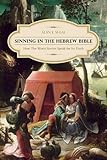Sinning in the Hebrew Bible : how the worst stories speak for its truth / Alan F. Segal.
Material type: TextPublication details: New York : Columbia University Press, ©2012.Description: 1 online resource (286 pages)Content type:
TextPublication details: New York : Columbia University Press, ©2012.Description: 1 online resource (286 pages)Content type: - 9780231504348
- 0231504349
- Bible. Old Testament -- Criticism, interpretation, etc
- Bible. Old Testament -- Criticism, interpretation, etc
- Bible. Old Testament
- Bibel
- Sin -- Biblical teaching
- Péché -- Enseignement biblique
- RELIGION / Christian Theology / Ethics
- RELIGION / Biblical Studies / Old Testament
- RELIGION / Judaism / Sacred Writings
- Sin -- Biblical teaching
- Sünde
- Biblische Theologie
- 221.6 241.3 241/.3
- BS1199.S54 S44 2012
- online - EBSCO
| Item type | Current library | Call number | URL | Status | Notes | Barcode | |
|---|---|---|---|---|---|---|---|
 eBook
eBook
|
Biblioteca "Angelicum" Pont. Univ. S.Tommaso d'Aquino Nuvola online | online - EBSCO (Browse shelf(Opens below)) | Online access | Not for loan (Accesso limitato) | Accesso per gli utenti autorizzati / Access for authorized users | (ebsco)1246238 |
Includes bibliographical references and index.
Introduction : The Bible and myth -- The matriarch in peril -- The golden calf : a lesson in chronology -- A historical tragedy : the short-lived Deuteronomic reform -- The concubine of the Levite : a complete horror -- The horror of human sacrifice : sex, intermarriage, and proper descent -- Ways of a man with a woman -- No peace in the royal family -- Conclusion : Synoptic sinning.
Stories of rape, murder, adultery, and conquest raise crucial issues in the Hebrew Bible, and their interpretation helps societies form their religious and moral beliefs. From the sacrifice of Isaac to the adultery of David, narratives of sin engender vivid analysis and debate, powering the myths that form the basis of the religious covenant, or the relationship between a people and their God. Rereading these stories in their different forms and varying contexts, Alan F. Segal demonstrates the significance of sinning throughout history and today. Drawing on literary and historical theory, as well as research in the social sciences, he explores the motivation for creating sin stories, their prevalence in the Hebrew Bible, and their possible meaning to Israelite readers and listeners. After introducing the basics of his approach and outlining several hermeneutical concepts, Segal conducts seven linked studies of specific narratives, using character and text to clarify problematic terms such as "myth," "typology," and "orality." Following the reappearance and reinterpretation of these narratives in later compositions, he proves their lasting power in the mythology of Israel and the encapsulation of universal, perennially relevant themes. Segal ultimately positions the Hebrew Bible as a foundational moral text and a history book, offering uncommon insights into the dating of biblical events and the intentions of biblical authors.
Print version record.


